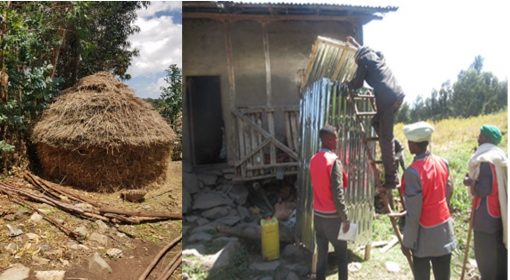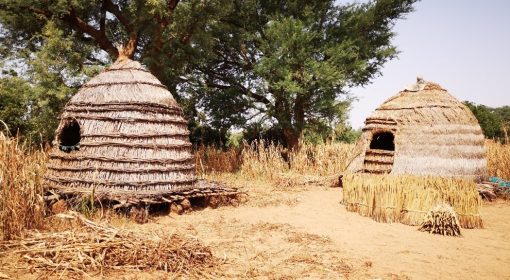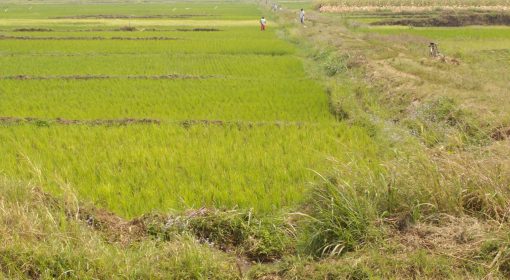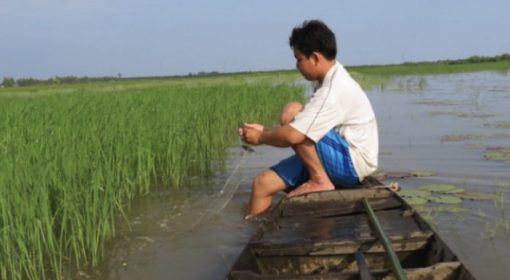By Luwieke Bosma, Saroj Yakami, Dikhyani and Abraham Abhishek
We are in India, in the state of Madhya Pradesh. Here many people belong first and foremost to their tribal community, such as Gond or Baiga. Many of these communities live remote and secluded, some hardly participate in the society at large. They have kept their own practices, beliefs and wisdoms.
Kumharra and Dhamanpani (locally called “Mars”) are 2 villages in this arid hilly tract of Madhya Pradesh. They grow paddy rice, millets, a variety of pulses and grams, and some vegetables in the monsoon season. Mainly for their own sustenance, where part of the crops is sold at the market as well, in return for items such as oil and spices.
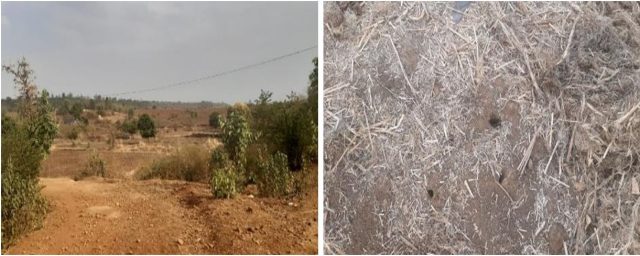
When we visited these villages and asked about rodents, and rats in particular, people reacted surprised “we have never been asked about rats before”. And the question was raised “have you come all the way to ask us about rodents?” They are familiar with talking about their water issues and methods of irrigation, their cropping patterns, seeds, even pest management, but never about rodent pests. With the surprise also comes a waterfall of stories, everybody knows how clever rats are, where they nest, what they eat, and the different species in their area. The villagers could easily identify 5 species, and sometimes up to 10, including their physical features, habitat, breeding habits and behaviour. Species living in the forest include Chauradal, Bhaisadal, Baanskata and Kotheli. Species occurring in field and homes are Chote, Gharuli, Tharela, Ghuus, Bandrachote and Chu-chu. The ‘Tharela’ is most notorious, it weighs 250-500 gram and can do 20% of damage to a 1-acre millet crop all by itself.

We find out that they do huge damage on field and in storage, on average it is estimated at 20-30%, with some outliers of 50% of damage. Huge numbers, and it may surprise us why this was never discussed before!
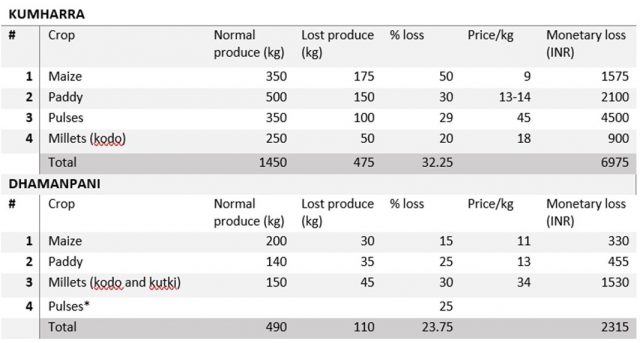
* Pulses in Dhamanpani are normally intercropped with other crops, therefore people could not indicate normal and lost produce. It was used for own consumption.
Rice is generally produced by everybody and is highly damaged. Two different methods of rice planting are used, either broadcasting seeds or starting with a nursery then later transplanting rice in rows. With the former method rats damage the rice at an early growth stage, but with the latter rats only eat the paddy rice at mature stage. Reason being that broadcasting is done on ‘poor’ land with little soil moisture, rats can easily enter at any time in the season. While rice that is transplanted grows on fields that have high soil moisture, rats do not like this, so they only come with harvest time when soils are dried up.
But then it is not only crops they damage, all household items are popular to the often insatiable rats, like documents and clothes. One woman shared rats had damaged her brand-new sari’s! And rats dig holes in the walls of all types of houses: mud, bricks or concrete.


We heard many stories, that show the rich wisdom and culture, though can also showcase some challenges for effective rodent management. A few examples:
- In the beginning of Kharif/monsoon season, the Baiga tribe does praying of “Thakur Dev”. A prayer whereby seeds/grains are distributed to all the community members, who during sowing time sow a few of these seeds in their field for every crop they grow. This is done to ask a blessing for the land. When this is done well by everybody, it is believed that there is less damage done by animals.
- Owls are seen as ghosts, they represent death. Owls are so-called psychopomps, literally ‘guide of souls’, these are creatures, spirits, angels or deities in many religions whose responsibility is to escort newly deceased souls from earth to afterlife. Owls are therefore often driven away because they are seen as bad omen. However, owls would be excellent rodent predators!
- A story shared by an older man: “There once was an old person in a house who used a rope to tie a mouse, so it could not eat the stored food. But then his yield started to decrease. The person concluded it is not good to control the mouse completely, the mouse also needs to eat.” The tribal community explained that they believe that all animals have a place in the food chain, we therefore do not wipe out a single species. Every species has a right to live thus must get some food to eat.
- A shopkeeper joked at our question whether rats damage his grains that “rats are gods, they give me a lot of blessings, they make me rich”. It was said as a joke, however rats are worshipped in parts of India.
- Few people called shrews goddesses, since shrews did not take the rat poison and were recognized as being helpful to the environment. It shows the deep knowledge of the different species and their function in the larger ecosystem.
When discussing the management options, we found encouraging examples. However generally such rodent management methods were practiced by a few people who learned the technique from their parents and grandparents. There is a huge gap in local knowledge transfer of traditional methods. Out of hundred families some five would know. In the absence of ecological rodent management, many people now take recourse to chemical poisons, even though they know rats are too clever and avoid these. Hence, people now often don’t control rodents, but only try to kill when they encounter them. This never works because by that time the rodent population has already grown too large.
Below two traditional rodent management methods are mentioned, with the room for improvement to make it more effective, building upon what is being done and optimising it.
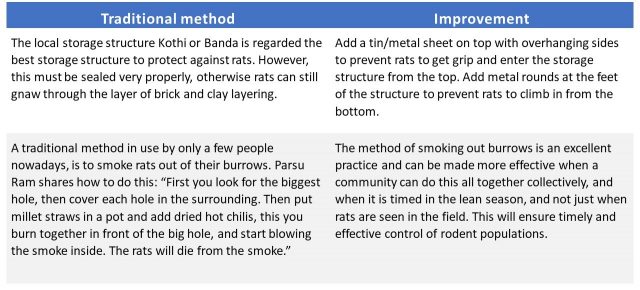
What did we learn and where to take it from here?
- The rich knowledge on rodents, different species and their behaviour; forms an excellent foundation to build effective rodent management approach and methods. When starting to talk about rats literally everybody has stories and experiences to share. It is important to have this dialogue, since people will learn from each other on challenges faced and other methods
- People recognize the need to control rats and have big interest in support. It requires in-depth knowhow of the cultural and physical components in the villages to tailor the methods and to allow them time to try to see what works best for them.
- There are a number of simple adaptations to existing methods and structures, mainly focusing on having a collective and timely approach.
- A locally tailored community based approach of ecologically based rodent management consisting of controlling habitats, denying access to food, interrupting rodent movement, using culturally acceptable predators, selected trapping and killing – undertaken particularly in the lean season when the rodent population is still small – can make a major contribution to improved food security.
